AZ-304 : Microsoft Azure Architect Design : Part 05
AZ-304 : Microsoft Azure Architect Design : Part 05
-
HOTSPOT
You have a resource group named RG1 that contains the objects shown in the following table.

AZ-304 Microsoft Azure Architect Design Part 05 Q01 057 You need to configure permissions so that App1 can copy all the secrets from KV1 to KV2. App1 currently has the Get permission for the secrets in KV1.
Which additional permissions should you assign to App1? To answer, select the appropriate options in the answer area.
NOTE: Each correct selection is worth one point.

AZ-304 Microsoft Azure Architect Design Part 05 Q01 058 Question 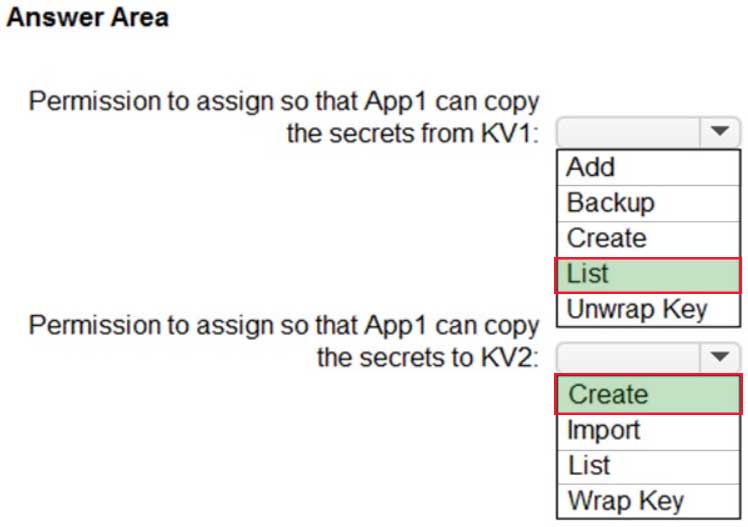
AZ-304 Microsoft Azure Architect Design Part 05 Q01 058 Answer Explanation:Box 1: List
Get: Gets the specified Azure key vault.
List: The List operation gets information about the vaults associated with the subscription.Box 2: Create
Create Or Update: Create or update a key vault in the specified subscription. -
Note: This question is part of a series of questions that present the same scenario. Each question in the series contains a unique solution that might meet the stated goals. Some question sets might have more than one correct solution, while others might not have a correct solution.
After you answer a question in this section, you will NOT be able to return to it. As a result, these questions will not appear in the review screen.
Your company has deployed several virtual machines (VMs) on-premises and to Azure. Azure ExpressRoute has been deployed and configured for on-premises to Azure connectivity.
Several VMs are exhibiting network connectivity issues.
You need to analyze the network traffic to determine whether packets are being allowed or denied to the VMs.
Solution: Install and configure the Microsoft Monitoring Agent and the Dependency Agent on all VMs. Use the Wire Data solution in Azure Monitor to analyze the network traffic.
Does the solution meet the goal?
- Yes
- No
Explanation:Instead use Azure Network Watcher to run IP flow verify to analyze the network traffic.
Note: Wire Data looks at network data at the application level, not down at the TCP transport layer. The solution doesn’t look at individual ACKs and SYNs.
-
Note: This question is part of a series of questions that present the same scenario. Each question in the series contains a unique solution that might meet the stated goals. Some question sets might have more than one correct solution, while others might not have a correct solution.
After you answer a question in this section, you will NOT be able to return to it. As a result, these questions will not appear in the review screen.
Your company has deployed several virtual machines (VMs) on-premises and to Azure. Azure ExpressRoute has been deployed and configured for on-premises to Azure connectivity.
Several VMs are exhibiting network connectivity issues.
You need to analyze the network traffic to determine whether packets are being allowed or denied to the VMs.
Solution: Use the Azure Traffic Analytics solution in Azure Log Analytics to analyze the network traffic.
Does the solution meet the goal?
- Yes
- No
Explanation:
Instead use Azure Network Watcher to run IP flow verify to analyze the network traffic. -
HOTSPOT
You manage a database environment for a Microsoft Volume Licensing customer named Contoso, Ltd. Contoso uses License Mobility through Software Assurance.
You need to deploy 50 databases. The solution must meet the following requirements:
– Support automatic scaling.
– Minimize Microsoft SQL Server licensing costs.What should you include in the solution? To answer, select the appropriate options in the answer area.
NOTE: Each correct selection is worth one point.
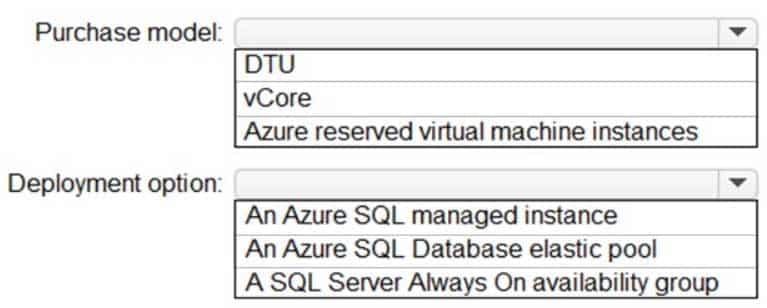
AZ-304 Microsoft Azure Architect Design Part 05 Q04 059 Question 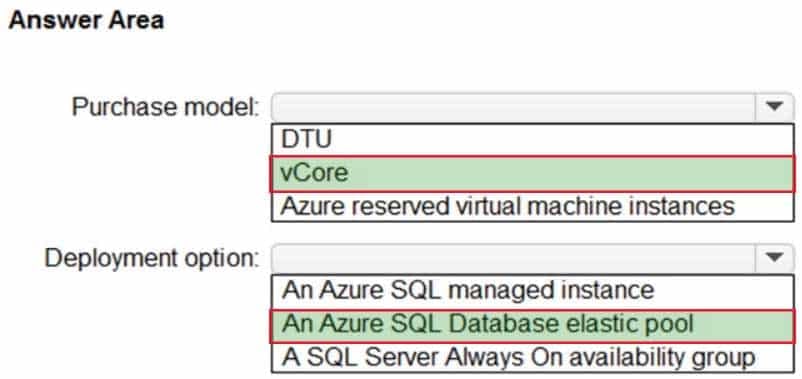
AZ-304 Microsoft Azure Architect Design Part 05 Q04 059 Answer Explanation:Box 1: vCore
Virtual core (vCore)-based purchasing model (recommended). This purchasing model provides a choice between a provisioned compute tier and a serverless compute tier. With the provisioned compute tier, you choose the exact amount of compute resources that are always provisioned for your workload. With the serverless compute tier, you specify the autoscaling of the compute resources over a configurable compute rangeBox 2: An Azure SQL Database Elastic pool
Azure SQL Database provides the following deployment options for a database:
Single database represents a fully managed, isolated database.
Elastic pool is a collection of single databases with a shared set of resources, such as CPU or memory. Single databases can be moved into and out of an elastic pool. -
DRAG DROP
You plan to import data from your on-premises environment into Azure. The data is shown in the following table.

AZ-304 Microsoft Azure Architect Design Part 05 Q05 060 What should you recommend using to migrate the data? To answer, drag the appropriate tools to the correct data sources. Each tool may be used once, more than once, or not at all. You may need to drag the split bar between panes or scroll to view content.
NOTE: Each correct selection is worth one point.

AZ-304 Microsoft Azure Architect Design Part 05 Q05 061 Question 
AZ-304 Microsoft Azure Architect Design Part 05 Q05 061 Answer -
You have an Azure virtual machine named VM1 that runs Windows Server 2019 and contains 500 GB of data files.
You are designing a solution that will use Azure Data Factory to transform the data files, and then load the files to Azure Data Lake Storage.
What should you deploy on VM1 to support the design?
- the Azure Pipelines agent
- the Azure File Sync agent
- the On-premises data gateway
- the self-hosted integration runtime
Explanation:The integration runtime (IR) is the compute infrastructure that Azure Data Factory uses to provide data-integration capabilities across different network environments. For details about IR, see Integration runtime overview.
A self-hosted integration runtime can run copy activities between a cloud data store and a data store in a private network. It also can dispatch transform activities against compute resources in an on-premises network or an Azure virtual network. The installation of a self-hosted integration runtime needs an on-premises machine or a virtual machine inside a private network.
-
HOTSPOT
Your company is designing a multi-tenant application that will use elastic pools and Azure SQL databases. The application will be used by 30 customers.
You need to design a storage solution for the application. The solution must meet the following requirements:
Operational costs must be minimized.
All customers must have their own database.
The customer databases will be in one of the following three Azure regions: East US, North Europe, or South Africa North.What is the minimum number of elastic pools and Azure SQL Database servers required? To answer, select the appropriate options in the answer area.
NOTE: Each correct selection is worth one point.

AZ-304 Microsoft Azure Architect Design Part 05 Q07 062 Question 
AZ-304 Microsoft Azure Architect Design Part 05 Q07 062 Answer Explanation:Box 1: 3
The server, its pools & databases must be in the same Azure region under the same subscription.Box 2: 3
A server can have up to 5000 databases associated to it. -
You are reviewing an Azure architecture as shown in the Architecture exhibit. (Click the Architecture tab.)

AZ-304 Microsoft Azure Architect Design Part 05 Q08 063 The estimated monthly costs for the architecture are shown in the Costs exhibit. (Click the Costs tab.)

AZ-304 Microsoft Azure Architect Design Part 05 Q08 064 The log files are generated by user activity to Apache web servers. The log files are in a consistent format. Approximately 1 GB of logs are generated per day. Microsoft Power BI is used to display weekly reports of the user activity.
You need to recommend a solution to minimize costs while maintaining the functionality of the architecture.
What should you recommend?
- Replace Azure Synapse Analytics and Azure Analysis Services with SQL Server on an Azure virtual machine.
- Replace Azure Synapse Analytics with Azure SQL Database Hyperscale.
- Replace Azure Data Factory with CRON jobs that use AzCopy.
- Replace Azure Databricks with Azure Machine Learning.
Explanation:AzCopy is a command-line utility that you can use to copy blobs or files to or from a storage account.
Cron is one of the most useful utility that you can find in any Unix-like operating system. It is used to schedule commands at a specific time. These scheduled commands or tasks are known as “Cron Jobs”.
-
You deploy Azure App Service Web Apps that connect to on-premises Microsoft SQL Server instances by using Azure ExpressRoute. You plan to migrate the SQL Server instances to Azure.
Migration of the SQL Server instances to Azure must:
– Support automatic patching and version updates to SQL Server.
– Provide automatic backup services.
– Allow for high-availability of the instances.
– Provide a native VNET with private IP addressing.
– Encrypt all data in transit.
– Be in a single-tenant environment with dedicated underlying infrastructure (compute, storage).You need to migrate the SQL Server instances to Azure.
Which Azure service should you use?
- SQL Server in a Docker container running on Azure Container Instances (ACI)
- SQL Server in Docker containers running on Azure Kubernetes Service (AKS)
- SQL Server Infrastructure-as-a-Service (IaaS) virtual machine (VM)
- Azure SQL Database Managed Instance
- Azure SQL Database with elastic pools
Explanation:
Azure SQL Database Managed Instance configured for Hybrid workloads. Use this topology if your Azure SQL Database Managed Instance is connected to your on-premises network. This approach provides the most simplified network routing and yields maximum data throughput during the migration. -
You plan to store data in Azure Blob storage for many years. The stored data will be accessed rarely.
You need to ensure that the data in Blob storage is always available for immediate access. The solution must minimize storage costs.
Which storage tier should you use?
- Cool
- Archive
- Hot
Explanation:Data in the cool access tier can tolerate slightly lower availability, but still requires high durability, retrieval latency, and throughput characteristics similar to hot data. For cool data, a slightly lower availability service-level agreement (SLA) and higher access costs compared to hot data are acceptable trade-offs for lower storage costs.
Incorrect Answers:
B: Archive storage stores data offline and offers the lowest storage costs but also the highest data rehydrate and access costs.
Archive – Optimized for storing data that is rarely accessed and stored for at least 180 days with flexible latency requirements (on the order of hours). -
DRAG DROP
You are designing a virtual machine that will run Microsoft SQL Server and will contain two data disks. The first data disk will store log files, and the second data disk will store data. Both disks are P40 managed disks.
You need to recommend a caching policy for each disk. The policy must provide the best overall performance for the virtual machine while preserving integrity of the SQL data and logs.
Which caching policy should you recommend for each disk? To answer, drag the appropriate policies to the correct disks. Each policy may be used once, more than once, or not at all. You may need to drag the split bar between panes or scroll to view content.

AZ-304 Microsoft Azure Architect Design Part 05 Q11 065 Question 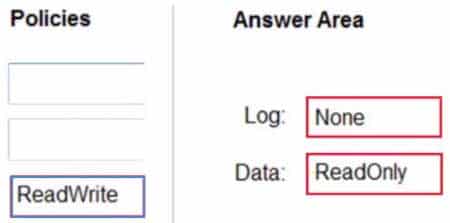
AZ-304 Microsoft Azure Architect Design Part 05 Q11 065 Answer -
You are designing a SQL database solution. The solution will include 20 databases that will be 20 GB each and have varying usage patterns.
You need to recommend a database platform to host the databases. The solution must meet the following requirements:
– The compute resources allocated to the databases must scale dynamically.
– The solution must meet an SLA of 99.99% uptime.
– The solution must have reserved capacity.
– Compute charges must be minimized.What should you include in the recommendation?
- 20 databases on a Microsoft SQL server that runs on an Azure virtual machine in an availability set
- 20 instances of Azure SQL Database serverless
- 20 databases on a Microsoft SQL server that runs on an Azure virtual machine
- an elastic pool that contains 20 Azure SQL databases
Explanation:Azure SQL Database elastic pools are a simple, cost-effective solution for managing and scaling multiple databases that have varying and unpredictable usage demands. The databases in an elastic pool are on a single server and share a set number of resources at a set price. Elastic pools in Azure SQL Database enable SaaS developers to optimize the price performance for a group of databases within a prescribed budget while delivering performance elasticity for each database.
Guaranteed 99.995 percent uptime for SQL Database
-
You have an app named App1 that uses two on-premises Microsoft SQL Server databases named DB1 and DB2.
You plan to migrate DB1 and DB2 to Azure.
You need to recommend an Azure solution to host DB1 and DB2. The solution must meet the following requirements:
– Support server-side transactions across DB1 and DB2.
– Minimize administrative effort to update the solution.What should you recommend?
- two Azure SQL databases in an elastic pool
- two Azure SQL databases on different Azure SQL Database servers
- two Azure SQL databases on the same Azure SQL Database managed instance
- two SQL Server databases on an Azure virtual machine
Explanation:SQL Managed Instance enables system administrators to spend less time on administrative tasks because the service either performs them for you or greatly simplifies those tasks.
Note: Azure SQL Managed Instance is designed for customers looking to migrate a large number of apps from an on-premises or IaaS, self-built, or ISV provided environment to a fully managed PaaS cloud environment, with as low a migration effort as possible. Using the fully automated Azure Data Migration Service, customers can lift and shift their existing SQL Server instance to SQL Managed Instance, which offers compatibility with SQL Server and complete isolation of customer instances with native VNet support. With Software Assurance, you can exchange your existing licenses for discounted rates on SQL Managed Instance using the Azure Hybrid Benefit for SQL Server. SQL Managed Instance is the best migration destination in the cloud for SQL Server instances that require high security and a rich programmability surface.
-
You have an Azure subscription that contains the resources shown in the following table.

AZ-304 Microsoft Azure Architect Design Part 05 Q14 065a You need to archive the diagnostic data for VNET1 for 365 days. The solution must minimize costs.
Where should you archive the data?
- Workspace1
- storage1
- storage2
Explanation:Incorrect Answers:
A: When you create a new workspace, it automatically creates several Azure resources that are used by the workspace:
– Azure Storage account: Is used as the default datastore for the workspace.Note: The workspace is the top-level resource for Azure Machine Learning, providing a centralized place to work with all the artifacts you create when you use Azure Machine Learning.
-
You plan to create an Azure Cosmos DB account that uses the SQL API. The account will contain data added by a web application. The web application will send data daily.
– You need to recommend a notification solution that meets the following requirements:
– Sends email notifications when data is received from the web application
Minimizes compute costWhat should you include in the recommendation?
- Deploy an Azure logic app that has a SendGrid connector configured to use an Azure Cosmos DB action.
- Deploy a function app that is configured to use the Consumption plan and an Azure Event Hubs binding.
- Deploy a function app that is configured to use the Consumption plan and a SendGrid binding.
- Deploy an Azure logic app that has a webhook configured to use a SendGrid action.
Explanation:You can send email by using SendGrid bindings in Azure Functions. Azure Functions supports an output binding for SendGrid.
Note: When you’re using the Consumption plan, instances of the Azure Functions host are dynamically added and removed based on the number of incoming events.
-
HOTSPOT
You on-premises network contains a file server named Server1 that stores 500 GB of data.
You need to use Azure Data Factory to copy the data from Server1 to Azure Storage.
You add a new data factory.
What should you do next? To answer, select the appropriate options in the answer area.
NOTE: Each correct selection is worth one point.
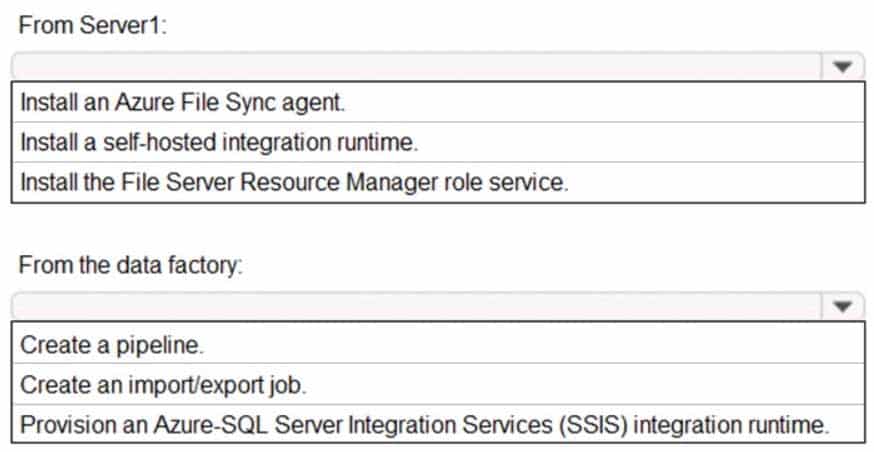
AZ-304 Microsoft Azure Architect Design Part 05 Q16 066 Question 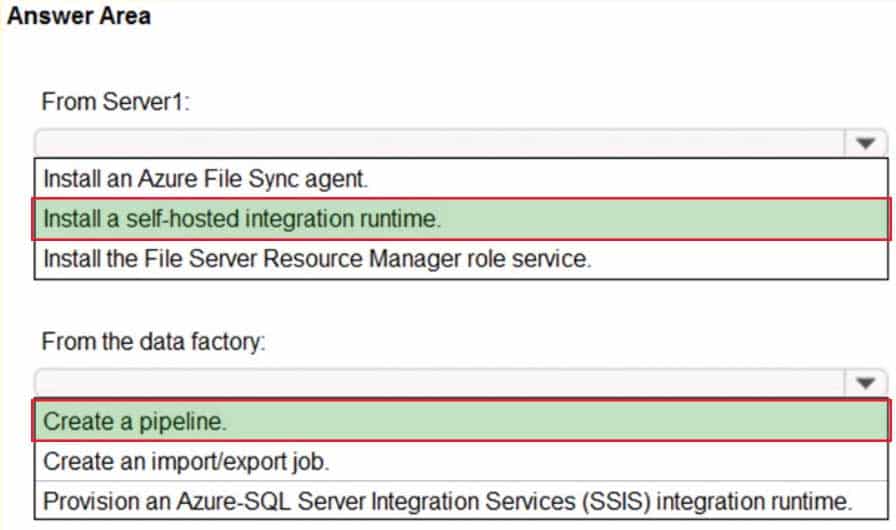
AZ-304 Microsoft Azure Architect Design Part 05 Q16 066 Answer Explanation:Box 1: Install a self-hosted integration runtime
The Integration Runtime is a customer-managed data integration infrastructure used by Azure Data Factory to provide data integration capabilities across different network environments.Box 2: Create a pipeline
With ADF, existing data processing services can be composed into data pipelines that are highly available and managed in the cloud. These data pipelines can be scheduled to ingest, prepare, transform, analyze, and publish data, and ADF manages and orchestrates the complex data and processing dependencies -
HOTSPOT
You have an on-premises file server that stores 2 TB of data files.
You plan to move the data files to Azure Blob storage in the Central Europe region.
You need to recommend a storage account type to store the data files and a replication solution for the storage account. The solution must meet the following requirements:
– Be available if a single Azure datacenter fails.
– Support storage tiers.
– Minimize cost.What should you recommend? To answer, select the appropriate options in the answer area.
NOTE: Each correct selection is worth one point.
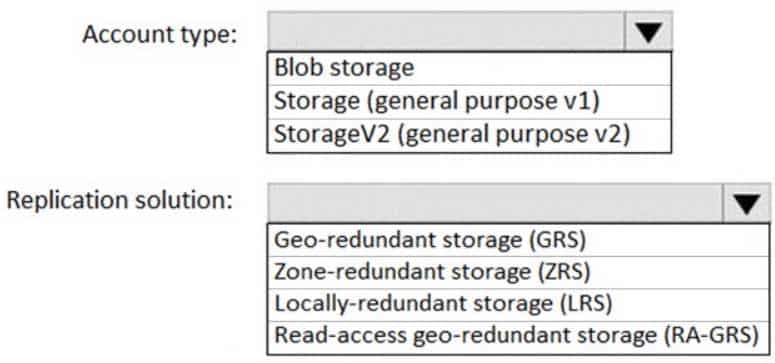
AZ-304 Microsoft Azure Architect Design Part 05 Q17 067 Question 
AZ-304 Microsoft Azure Architect Design Part 05 Q17 067 Answer Explanation:Box 1: Blob storage
Blob storage supports storage tiersNote: Azure offers three storage tiers to store data in blob storage: Hot Access tier, Cool Access tier, and Archive tier. These tiers target data at different stages of its lifecycle and offer cost-effective storage options for different use cases.
Box 2: Zone-redundant storage (ZRS)
Data in an Azure Storage account is always replicated three times in the primary region. Azure Storage offers two options for how your data is replicated in the primary region:
Zone-redundant storage (ZRS) copies your data synchronously across three Azure availability zones in the primary region.
Locally redundant storage (LRS) copies your data synchronously three times within a single physical location in the primary region. LRS is the least expensive replication option, but is not recommended for applications requiring high availability. -
Note: This question is part of a series of questions that present the same scenario. Each question in the series contains a unique solution that might meet the stated goals. Some question sets might have more than one correct solution, while others might not have a correct solution.
After you answer a question in this section, you will NOT be able to return to it. As a result, these questions will not appear in the review screen.
You are designing an Azure solution for a company that has four departments. Each department will deploy several Azure app services and Azure SQL databases.
You need to recommend a solution to report the costs for each department to deploy the app services and the databases. The solution must provide a consolidated view for cost reporting that displays cost broken down by department.
Solution: Create a resource group for each resource type. Assign tags to each resource group.
Does this meet the goal?
- Yes
- No
Explanation:
Tags enable you to retrieve related resources from different resource groups. This approach is helpful when you need to organize resources for billing or management. -
Note: This question is part of a series of questions that present the same scenario. Each question in the series contains a unique solution that might meet the stated goals. Some question sets might have more than one correct solution, while others might not have a correct solution.
After you answer a question in this section, you will NOT be able to return to it. As a result, these questions will not appear in the review screen.
You are designing an Azure solution for a company that has four departments. Each department will deploy several Azure app services and Azure SQL databases.
You need to recommend a solution to report the costs for each department to deploy the app services and the databases. The solution must provide a consolidated view for cost reporting that displays cost broken down by department.
Solution: Create a new subscription for each department.
Does this meet the goal?
- Yes
- No
Explanation:Instead, create a resources group for each resource type. Assign tags to each resource
Note: Tags enable you to retrieve related resources from different resource groups. This approach is helpful when you need to organize resources for billing or management.
-
Note: This question is part of a series of questions that present the same scenario. Each question in the series contains a unique solution that might meet the stated goals. Some question sets might have more than one correct solution, while others might not have a correct solution.
After you answer a question in this section, you will NOT be able to return to it. As a result, these questions will not appear in the review screen.
You are designing an Azure solution for a company that has four departments. Each department will deploy several Azure app services and Azure SQL databases.
You need to recommend a solution to report the costs for each department to deploy the app services and the databases. The solution must provide a consolidated view for cost reporting that displays cost broken down by department.
Solution: Place all resources in the same resource group. Assign tags to each resource.
Does the solution meet the goal?
- Yes
- No
Explanation:Instead, create a resources group for each resource type. Assign tags to each resource
Note: Tags enable you to retrieve related resources from different resource groups. This approach is helpful when you need to organize resources for billing or management.